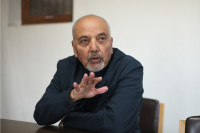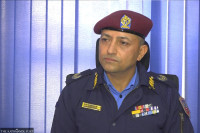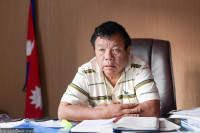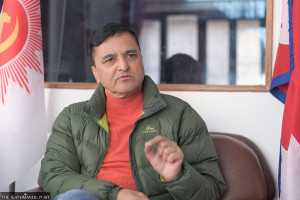Interviews
'We are open to criticism. We have to listen.'
The Post spoke to National Reconstruction Authority CEO Sushil Gyewali about the body's involvement in heritage restoration and culture conservation and the recent controversy surrounding Rani Pokhari.
Shashwat Pant
The National Reconstruction Authority (NRA) was established on December 25, 2015, with the objective of rapidly reconstructing buildings damaged by the 2015 earthquakes.
And since its formation, the authority has helped rebuild over 500,000 houses, over 10,000 schools and hospitals and over 900 heritage monuments. During this timeframe, the authority has also faced a lot of criticism when it comes to heritage reconstruction, especially when it comes to Rani Pokhari.
With the authority’s term coming to an end on December 25, the Authority’s CEO, Sushil Gyewali, spoke to the Post’s Shashwat Pant about the authority’s role in heritage restoration, the challenges it has faced and the criticism, and what the future is for heritage monuments after its term ends. Excerpts:
What works has the NRA done when it comes to heritage conservation? And why have many of the projects been delayed so much?
In total, we were assigned the restoration of around 920 heritage monuments throughout the country. Out of that, 170 were monuments in world heritage sites in the Kathmandu Valley, 404 heritage monuments within the Valley and 346 monuments were outside the Valley.
While working, we had to give first priority to private houses, schools and hospitals. But after that, our time and effort has been given to restoring damaged heritage monuments.
The reason why we put heritage restoration third on our priority list was because we wanted to ensure that the work we did was done in the right manner. We had to ensure that the right people were working in the restoration projects because working in heritage you need skilled artisans.
Another issue we had was finances. While we were getting decent donations for private houses, schools and hospitals from abroad, donations for heritage restoration were quite low. What little we had, we first started to work on world heritage sites in Kathmandu, then moved slowly towards other monuments which had been destroyed in the 2015 earthquake.
Till date, out of the 920 monuments, we have fully restored 453 monuments which includes fully restoring 105 heritage monuments which fall on the world heritage site list with only 65 now remaining to be restored.
How tough has it been to restore these monuments?
It has been tough. We were put back by multiple, unexpected issues. The first problem we had was lack of early documentation. We quickly realised that no two monuments, even though they looked similar, were the same. For example, we compared two temples built in the Malla time, and we found vast differences. And because many of the buildings were built in a different time, it was tough for us because the manner and the materials used to build the monuments were different.
The second problem we faced was lack of skilled manpower when it came to heritage restoration. These skills in earlier times would be passed on from one generation to another but that doesn’t happen anymore. That knowledge is limited, which is why we had to train a lot of people.
Another problem we face was that in some places, locals were not too compliant. For example, in the Aagan chhe: temple in Basantapur, whose restoration has been in limbo, locals didn’t want the Japanese to enter the shrine room of the temple to restore it. This put on hold its works for a long time. Another obstacle we faced was restoring the temple in the same manner it was built, which means producing similar bricks produced over two-three centuries ago with the same quality. This takes time.
The fourth challenge was convincing the community we were going to do a fair job. Because a lot of people’s lives revolved around these heritage monuments—from early morning prayers to evening prayers—we had to take them on board from the first brick, because if we didn’t do that, a lot of problems would be created in the future.
The last problem we had was to ensure that when restoring, we make the buildings structurally strong so that they wouldn't come down when another earthquake hit Nepal. Because we don’t want unsafe structures. But that contradicted traditional techniques because back then concrete wasn’t used. So we had to come up with ways we could strengthen it using age-old techniques.
What complaints do you get from public stakeholders?
They say they want to be involved in the restoration projects because they know the monuments well. They don’t want monuments to be given to construction companies who work with concrete, as the locals say that they won’t do justice to the project. But according to the Public Procurement Act, we can only give them monuments of up to Rs 10 million.
Taking that concern into consideration, we have made special provisions and increased that amount to Rs 1 billion. Using that, locals have made user groups in projects like Kastamandap, Rani Pokhari and recently Bungamati.
Who does the NRA prefer to give projects to? User committees or contractors?
Our first priority is always giving it to user committees. But there are some projects that cannot be done by them. Some are too big that user groups don’t want to take ownership because they don’t have the ability to do so, which is why we give it to contractors.
With time, we’ve realised that the contractors have developed a capacity to build these monuments. We’ve provided training to their staff who have become decent artisans capable of restoring temples. It’s not that their work goes unmonitored. Heritage activists regularly keep a check on them and we have a team of archeologists who monitor the work on a regular basis. There is no preference; we give projects based on the capability of the people.
Is the criticism that the NRA is getting fair?
We are open to criticism. We have to listen to them. At NRA, we want to ensure that the monuments are rebuilt in a way that ensures locals’ voices are heard too. We don’t want anyone to be unhappy and have always held dialogues with locals to ask what wrong we are doing. If their concerns are valid, we always correct it. But if their complaints are invalid, then we sit down, talk and explain to them.
We too need to understand why they are concerned and if their demands are just. But sometimes some criticisms are politically motivated too.
Why has Rani Pokhari come under so much scrutiny?
When people came to us asking us not to use concrete, we took their advice and started from scratch. But then people started to tell us that the water in the pond came automatically from a source within the pond. We didn’t disregard that fact too. We then asked our team of archeologists to study if that was still possible. We dug deep to see if we could find water sources but we couldn’t.
There was a system of Raj Kulo (Royal Canal) back then. Those don't exist anymore. The public too needs to understand that. We are talking to authorities of the possibility of bringing in water from different ponds as well. But nothing is fixed yet.
Right now, people are concerned about the use of tube wells, which we have asserted is only a last resort. They want us to use only rain water. And we also want to use more sustainable measures: like rain water or water from Kathmandu’s Valley Water Management Board. But we have to look at all practical solutions.
Heritage activists have been saying we have been rushing to complete projects because our term is coming to an end. But the public wants the temple to be open at least by Tihar. We are caught in between. Yes, we do want to complete our projects before the end of our term too but that’s because otherwise it'll be further caught in a limbo.
There are rumours that NRA’s contract will be extended for a year. What is the plan of action for now?
When deriving the five-year plan, when we started, we had said that restoring heritage monuments would take at least six years. We would have completed our works on time, if not for various hindrances, including Covid-19. There is a likelihood that it will be extended by a year but nothing is sure yet.
When our contract ends, we will handover everything to the Department of Archeology, with whom we have been working in close coordination with all this while.




 8.12°C Kathmandu
8.12°C Kathmandu












